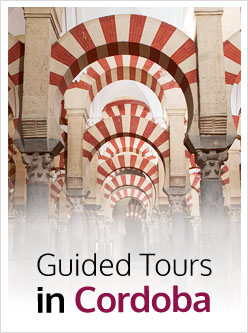The Church of Santiago has a floor with three naves, the central one being higher and wider than the rest. The apse consists of three polygonal apses, of which the central one can be seen from the outside, where it is reinforced with buttresses, whereas the side ones are straight, as we saw with the neighbouring Church of San Pedro.
The naves are connected between them through three big round arches, supported by pilasters attached to pillars. Over the arches, there is a cornice all along the central nave, even on the apse which closes it. Further up, we can see the typical reinforced wall, with three blind pointed arches corresponding to the round ones mentioned earlier. Inside, some small openings crowned by small round arches provide the nave with light. The reinforced wall supports the wooden roof.
When entering the Church of Santiago, the sight is astonishing, due to the cleanliness of the shapes and the white surrounding the temple. It is not a very big nave; in fact, the choir at its foot occupies a great deal of space.
The Nave of the Gospel has an irregular floor, as its two first sections are narrower, mainly because of the presence of the old minaret. What has been preserved from it is the current section of the bell gable, which can be accessed through a spiral staircase. From the inside, we can see a double-lancet window, consisting of two horseshoe arches supported by a small polygonal column. On the other hand, at the foot of this nave, two original capitals are preserved from the 13th century. The covering is made through a wooden monopitch roof, substituting the primitive Gothic ribbed vaults.
The Nave of the Epistle does preserve the ribbed vaults, but in this case they are restored. From them, the current rooms of the parish start, which will be explained in the section dedicated to chapels and altars.
The apse of the Epistle is the only one with its original appearance. It is covered by a Gothic ribbed vault, with a central rib, and the special thing about it is that the only support used is the column, unlike other examples in our city. We can highlight the use of the central rib, with a typical influence from Burgos, decorated in zig-zag, as well as the keystones of the arches decorated with several flowery motifs.
The side façade is not medieval; it consists of a triple arcade leading to a sort of hall, with a lintelled door made in the 19th century, which is the entrance to the inside of the temple. Throughout the years, the Church of Santiago has witnessed how the houses of the neighbourhood have come closer, up to a point where it seems to be just one more building on Agustín Moreno Street.
The medieval entrance, located on the very narrow Ronquillo Briceño Street, cannot be seen comfortably, as we do not have the necessary perspective. Its resemblance to the entrance of the Church of San Miguel is more than evident. It consists of a pointed arch with moulded archivolt and extrados decorated with diamond ends. Over the entrance opening there is a small roof supported by round modillions.
If you are wondering what to visit in Córdoba, a good option would be the Fernandine Churches, choosing one of our guided tours. This way you will learn everything about the Church of Santiago. Choosing to do high quality sightseeing is choosing ArtenCórdoba.
Text: J.A.S.C.


Choose the tour that best suits your needs and book your place on one of our regular guided tours.
The regular guided tours are those that you can sign up for individually, are conducted regularly and in one language, Spanish or English
Guided Visit Mosque-Cathedral of Cordoba
5 / 5
13€
Guided Visit to the Mosque of Cordoba and the Jewish Quarter
5 / 5
Desde
17€
Guided Tour Cordoba in depth
5 / 5
Desde
40€
Guided Visit Medina Azahara
5 / 5
Desde
18€





















